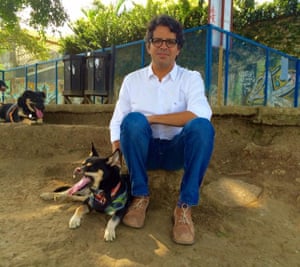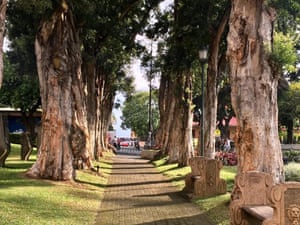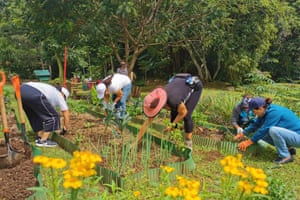“Pollinators were the key,” says Edgar Mora, reflecting on the decision to recognise every bee, bat, hummingbird and butterfly as a citizen of Curridabat during his 12-year spell as mayor.
“Pollinators are the consultants of the natural world, supreme reproducers and they don’t charge for it. The plan to convert every street into a biocorridor and every neighbourhood into an ecosystem required a relationship with them.”
The move to extend citizenship to pollinators, trees and native plants in Curridabat has been crucial to the municipality’s transformation from an unremarkable suburb of the Costa Rican capital, San Jose, into a pioneering haven for urban wildlife.
Now known as “Ciudad Dulce” – Sweet City – Curridabat’s urban planning has been reimagined around its non-human inhabitants. Green spaces are treated as infrastructure with accompanying ecosystem services that can be harnessed by local government and offered to residents. Geolocation mapping is used to target reforestation projects at elderly residents and children to ensure they benefit from air pollution removal and the cooling effects that the trees provide. The widespread planting of native species underscores a network of green spaces and biocorridors across the municipality, which are designed to ensure pollinators thrive.
Q&A What is wild cities week?
Show
Hide
This week, the Guardian’s Age of Extinction site is looking at biodiversity in cities and urban areas around the world, shining a spotlight on the under-appreciated world of nature hidden among the highrises and busy roads.
Around 55% of the world’s population live in urban areas and that number is projected to rise to 68% by 2050. Nature’s role in the wellbeing and happiness of billions of people will be more important than ever. While urbanisation is a major driver of biodiversity loss, many conservationists and town planners are trying to make built-up areas more nature-friendly. The role of green spaces in urban areas has even been formalised in a draft UN agreement to halt and reverse biodiversity loss, often referred to as the Paris agreement for nature.
The Covid-19 outbreak has seen cities and towns across the world go into lockdown which has enabled wildlife such as wild boar, deer, monkeys, foxes and even lions to venture into territory previously dominated by humans. It has also offered us the chance to notice and appreciate the natural world in cities in an unprecedented way.
In this special series of reports we’ll be looking at how animals and plants adapt to city life, what to look out for right now and how we can encourage more wild cities in the future.

“The idea came from a narrative that people in cities are prone to defending nature when it is far away, when it is a distant concept, but they are negligent when it comes to protecting nature in their immediate environment,” says Mora, who has since become a senior design strategist with the global architecture firm Gensler, after a brief spell as education minister.
“Urban development should be, at least to some extent, aligned with the landscape instead of the other way round,” he says.
‘Cities are a long way behind’
The metropolitan area surrounding San Jose is home to more than 2 million people – about half of the population of Costa Rica – despite covering less than 5% of the country’s area.
Were it not for the lush volcanic peaks that surround Costa Rica’s central valley, it would not be immediately obvious that you were in the heart of one of the most biodiverse countries on the planet. Humans dominate and the country’s cloud forests, pristine coastline and emblematic sloths can feel a long way from the concrete and traffic.
“We attract a lot of tourists because of nature and conservation but there is still friction in the city,” says Irene Garcia, head of innovation at the mayor’s office in Curridabat, who oversees the Sweet City project. “Places like San Jose do not represent what we sell as a country or what you see in rural areas or the beaches. Costa Rica has differentiated itself significantly but our cities are a long way behind.”

Urbanisation is one of the primary drivers of biodiversity loss around the world, according to the Intergovernmental Science-Policy Platform on Biodiversity and Ecosystem Services (IPBES), with urban areas having doubled since 1992. By the middle of the century, the UN projects that 68% of humanity will live in towns and cities, placing further pressure on ecosystems and rapidly vanishing habitats.
But many urban planners are trying to change this relationship and the importance of green spaces in towns and cities has been recognised in a draft UN agreement to halt and reverse biodiversity loss, often referred to as the Paris agreement for nature.
Sweet City is just one of a number of biocorridors around the country that allow the genetic spread of species to maintain their strength. In Central America, this concept has developed since the early 2000s following an agreement to form a biocorridor network to connect jaguars.
“Grey infrastructure makes the city warm up too much. So the idea to connect green areas is to cool down parts of the city, return the ecosystem services that were there previously but have deteriorated,” says Magalli Castro Alvarez, who oversees Costa Rica’s network of biocorridors with the National System of Conservation Areas (Sinac).

“Inter-urban biocorridors have a double objective: they create ecological connectivity for biodiversity but also improve green infrastructure through roads and river banks lined with trees that are linked with the small forested areas that still exist in metropolitan areas. They improve air quality, water quality and give people spaces to relax, have fun and improve their health.”
Many Costa Ricans are happy to speak about the policy benefits of schemes such as Sweet City , as their response to the challenges of bringing nature into the city is part of a deeper national sentiment. It is not in this tiny Central American country’s DNA to behave as if humans were somehow set apart from nature.
It was a Costa Rican, Christiana Figueres, who brought the world together to reach the Paris agreement. More than 98% of Costa Rica’s energy comes from renewable sources and it plans to completely decarbonise by 2050 – one of the most ambitious goals on the planet. The country has also successfully reversed one of the world’s highest deforestation rates.

“In Costa Rica, you can start your day in the Caribbean, in the Atlantic ocean, but then you can travel and on the same day, you can see the sun set in the Pacific,” says the country’s president, Carlos Alvarado Quesada, who credits Costa Rica’s tradition of pacifism and respect for nature with its desire to tackle big environmental issues.
“Even though we have a small territory, its characteristics allow us to have 6% of the biodiversity of the world in our land. Those are traits that are special.
“I had to travel far away to understand that many of the answers were back home and the challenge was taking that legacy to the next level.”
Find more age of extinction coverage here, and follow biodiversity reporters Phoebe Weston and Patrick Greenfield on Twitter for all the latest news and features